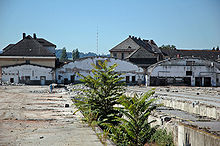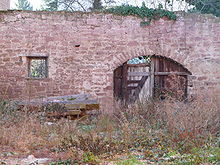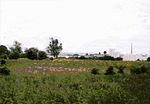fallow
A fallow land (regionally also Gstettn ) is a piece of land ( arable or meadow ) that is unused for economic , regenerative or other reasons . Any built-up property that was once in human use (see cultural landscape ), but which has been abandoned and has possibly left traces, can also be described as lying fallow . These traces, such as buildings or ruins , can impair subsequent use or even represent serious environmental damage. A special distinction is made between fallow land (functional fallow land for agricultural reasons) and fallow land as land that has not been cultivated for other reasons on the one hand and wasteland that cannot be cultivated or unproductive land on the other.
Fallow land types
Agricultural fallow land
In agriculture , once cultivated areas are not used for economic or regenerative reasons.
Historical origins
In a three-year cycle , winter cereals and summer cereals are grown one after the other , after which there is fallow land for a year in which the soil could recover. Since the re-cultivation of the fallow field usually took place in June of the following year, the old German name for this month was Brachet or Brachmond .
According to the account in the Old Testament of the Bible , the inhabitants of ancient Israel had to leave their fields fallow every seven years - in the so-called " Sabbath year ": "For six years you are to sow your field and for six years prune your vineyard and the produce of the country. But in the seventh year the land shall have its Sabbath of rest, a Sabbath for the Lord, on which you shall neither sow your field nor prune your vineyard ”( Lev 25,3-4 EU ).
Regenerative wasteland (cultivated wasteland)
The fallow years system is still used today, especially in so-called “unfavorable areas”, the ecological framework conditions of which do not permit land use without regeneration phases without causing soil depletion . These are, for example, large parts of the subtropics , in which the soils have little nutrient storage. If these regeneration times are not observed, the soil will degrade quickly and will no longer be usable for agriculture after a few years. Depending on the previous use, there is the forest fallow or garden fallow.
Field blocks are called fallow which:
- Rotational fallow
- short time
- Permanent fallow
- longer time
- Wasteland
- with vegetation
- without vegetation
be outsourced from the agricultural process. Depending on the former use, permanent fallow land may a. subdivided into fallow land , fallow grassland and fallow vineyards .
Effect of fallow:
- Implementation or supply of organic matter,
- Conversion of nutrients into soluble form (mineralization),
- Improvement of the soil structure (Gare),
- Reduction of the wild plant pressure (cupping cut, black mulch),
- Protection of the water balance.
Fallow land in the cultural landscape :
- Serves to keep the landscape open,
- Preservation of the arable character of the area,
- Groundwater recharge is promoted,
- Nutrient discharge is reduced,
- Promotion of the arable habitat (ground breeders, small game, bee pasture, insects),
- Reduce agricultural overproduction . Set aside .
Mulching the fallow land is allowed from July 15th. This serves to prevent the growth of shrubs and trees. To prevent the weeds from being sown, June 15 would be more suitable.
The abandoned land is fallow agricultural land as a result of abandonment due to changes in the social fabric ( "restructuring") of the rural population. The Alpine fallow is a social fallow and is used as a term mainly in German-speaking Switzerland.
Industrial, commercial and residential wasteland


Industrial wasteland (English also brownfields ) is a wasteland that arises after the industrial use of industrial facilities has ceased. The buildings and facilities are then abandoned to decay and / or dismantled (e.g. Krupp industrial wasteland in Essen and the former Karlsruhe repair shop ); even after the old facility has been demolished, it often takes several years to rebuild. A change in use or revitalization is often opposed to pollution of the soil and facilities by contaminated sites , which is often only possible after complex and cost-intensive renovation (e.g. Zeche Zollverein in Essen). The reintegration of brownfield sites into the economic cycle is known as land recycling .
Residential fallow land Less common are fallow land that emerges from former residential areas, similar to ghost towns or desertions . They can usually be found in regions that are affected by strong migration, for example due to the end of industries that were formerly operated there. On the other hand, there are more frequent individual plots of land whose previous development was demolished, but whose new development has not been carried out due to legal disputes or reasons of property speculation .
Depending on the previous use, there are:
- Demolition, disintegration or rubble wastelands
- Fallow land
- Colliery
- Soil degradation
- Landfill
- Broken tracks
- Fallow roads
- Military fallow
Vegetation development
After the abandonment of use, vegetation begins to develop ( succession ) at locations that are capable of vegetation . In the open ground, the vegetation development begins in a very simplified way with an annual field in the first year of fallow land and leads over perennial stands and tall herbaceous fields ( ruderal vegetation ) in the following years to encroachment , which finally turns into forest. This development can proceed very differently and at different speeds depending on the original vegetation and anthropogenic changes as well as the productivity of the location, the seed input from neighboring areas and by animals and the local climate. The following pictures show phases in the development of vegetation on fallow land.
See also
literature
- Mathias Güthling: Inner-city wastelands - investigations into the redesign of inner-city railway areas using the example of the Reichsbahnausbesserungswerk Potsdam (= workbooks of the Institute for Urban and Regional Planning of the TU Berlin. Volume 74). Berlin 2009, ISBN 978-3-7983-2107-6 .
- Tanja Hasselberg: Parks and gardens on fallow land. Conversion of industrial areas in the Ruhr area (= workbooks of the Rheinische Denkmalpflege. 77). Wernersche Verlagsgesellschaft, Worms 2011, ISBN 978-3-88462-316-9 .





